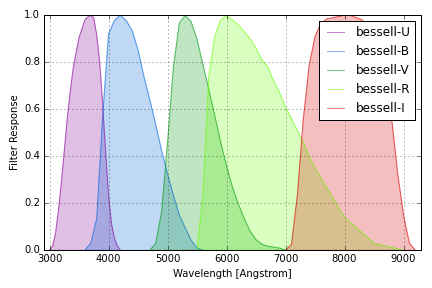PX282 - A6 - magnitudes, band passes, colours
magnitude
- astronomy uses magnitude to measure the brightness
- it is on a logarithmic scale
- originally, it was designed to mimic human eye response
apparent magnitude
- it is the magnitude as seen from a distance,
- for two stars with apparent magnitudes,
and , and fluxes, and
- the scale needs a zero-point, which is taken to be vega,
- therefore, the apparent magnitude for any star is:
-
this scale makes numbers easy to work with, eg:
- sirius,
- sun,
- proxima cententari,
- sirius,
-
note: larger the apparent magnitude, the fainter a fainter star
-
-
flux and magnitude are so far bolometric*, ie. measured across all wavelengths, or formally:
where,
- in practice, all wavelengths cannot be measured
ranges are selected using filters - a filter has a transmission function,
- eg:
at
colours and temperature

image; speclite developers
-
in a bandpass: -
has shorter than , so a star with a , has , is 'bluer' than vega ( in all bands) -
colour is a strong function of temperature
absolute magnitude
- it says how bright would a star would be if it were at a distance of
, ie: the magnitude of a star at a distance of - therefore,
- flux has an inverse square relation with the distance, ie:
- using equation
- if
then (brighter)